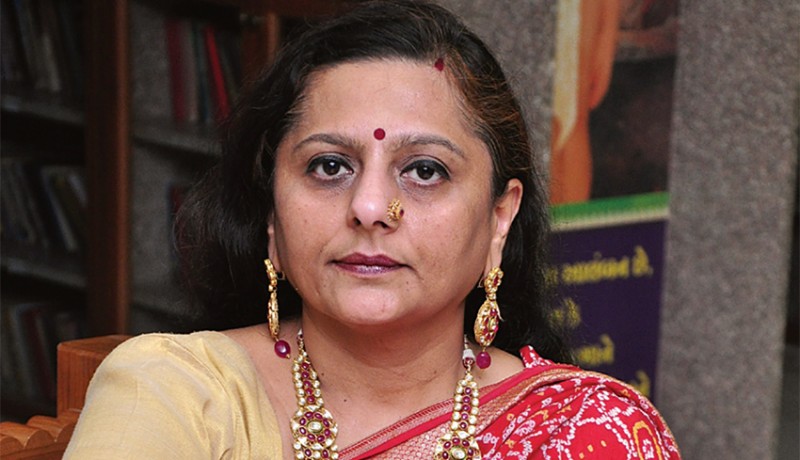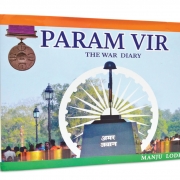
Etcetera

Manju Lodha spent her childhood in an atmosphere that reverberated with stories of Indian freedom fighters. At 18, she got married to Mangal Prabhat Lodha, son of Guman Malji Lodha, chief justice of Rajasthan High Court. Being a freedom fighter, Guman Lodha’s house too resonated with patriotic fervour and spirit. Gradually, Manju Lodha got associated with the activities of the Lodha Foundation, a charitable trust that focuses on health, education and development, besides undertaking relief work during calamities.
In 2014, the Lodha Foundation organised an event to commemorate 51 years of Aye mere watan ke logo, a patriotic song saluting Indian soldiers who laid down their lives during the 1962 Sino-Indian war. The programme, held in Mumbai, was attended by Prime Minister Narendra Modi; Lata Mangeshkar, who sang the song; Sargam Pradeep, the daughter of legendary lyricist Kavi Pradeep, who penned the song; and over 150,000 uniformed officers. One of the most touching moments, reminisces Lodha, was when every single person present at the event recited the song as a tribute to the martyrs. That, she says, “inspired me to pen a book on our bravehearts.” After intense research, she recently came up with Param Vir – The War Diary (Lodha Foundation; ₹ 400; 112 pages), which chronicles the journeys of our war heroes, from 1947 to the Kargil War. Rachna Virdi spoke to the 57 year-old writer, poet and social worker about the book, her inspiration and her social commitments. Excerpts from the interview:
Tell us more about Param Vir – The War Diary.
The Param Vir Chakra is the highest military award given to soldiers—dead or alive—for extraordinary courage during wars. From Independence till the Kargil War, only 21 soldiers have earned it, of which 14 got it posthumously. My book not only talks about wars that changed the history of India but highlights the journeys of those who have been awarded the Param Vir Chakra, Mahavir Chakra, Vir Chakra and Ashok Chakra. It captures the patriotism, bravery and sacrifice of our soldiers. I think the book will take people into the hearts and minds of those who sacrifice their lives so we continue to live.
Some of the stories are riveting. How did you gather the details?
A majority of Param Vir Chakra recipients are dead. So we had to draw out the details from record books and through talks with family members and comrades-in-arms. Some of the stories were spine-chilling! It’s unfortunate that most of these soldiers died young. Take, for instance, Major Shaitan Singh Bhati, who was newly married when he lost his life in the 1962 war. His body—with fingers still on the rifle’s trigger—was found by a shepherd on the slopes of the hills of Rezang La in Ladakh after the snow melted in summer. Then there was Flying Officer Nirmaljit Singh Sekhon, the only member of the Indian Air Force to be honoured with the Param Vir Chakra. Stationed in Srinagar, he was defending the valley from Pakistan Air Force’s jets when his fighter jet was hit and went down the mountainous terrain; his body was never found. Another tale is that of Second Lieutenant Arun Kshetrapal, who was 20 when he died during the 1971 Indo-Pak war.
What inspired you to pen this book?
We sleep peacefully thanks to the sacrifices made by our soldiers. We should be proud of our heroes and value the sacrifices made by them and their families for the country. This book is my humble tribute to them. As civilians, we cannot go to the border and fight the enemy but, as a nation, we must stand in solidarity with our armed forces. In my own little way, I’ve been trying to raise awareness through this book. I got 20,000 copies of the book distributed free of cost in my locality. After the Uri incident, our foundation has organised several programmes to collect funds for soldiers and their families.
Why do you think the book is a must-read for the current generation?
Unfortunately, the present generation doesn’t know much about the struggles of the Indian Army. I want youngsters to learn about our real heroes. Like Bhagavad-Gita, Quran and other spiritual books, which are a staple in many homes, children should also be acquainted with stories of patriotism. We’ve introduced the book in Lodha Schools, as well as other schools. I have three grandchildren and make it a point to read out stories from the book every day.
Tell us something about your journey as an author and social activist.
Being a young Marwari housewife, my life initially revolved around my family and children. Once my kids finished school, I associated myself with social organisations that worked for women’s empowerment and focused on my literary pursuits. We founded the Lodha Charitable Trust and Gyan Gangotri Kavya Manch, a forum that encourages housewives to indulge in creative writing. I am also actively involved with the Rajasthani Mahila Mandal, Jeenkushal Mahila Mandal and other social groups that work in the rural sector. Thanks to a reading and public speaking course, I also developed my writing and oratorical skills. Today, I have to my credit 11 Hindi books—Bharat Bhagya Nirmata, Babul, Paati, Maa and Yaaden, to name a few—and Param Vir, my first book in English. Recently, I presented a copy of Param Vir to our Prime Minister; it was a dream come true. Looking back, I feel happy with the way my life has shaped up.
Featured in Harmony — Celebrate Age Magazine January 2017
you may also like to read
-
Cracking the longevity code
Small yet impactful choices can be game-changers, writes Srirekha Pillai At 102, there’s no stopping Chandigarh-based Man Kaur, the world’s….
-
Home, not alone
While a regulatory framework is vital for senior-care facilities, the need of the hour is to develop an ecosystem to….
-
Birthday Girl
Published in a special edition to honour Japanese master storyteller Haruki Murakami’s 70th birthday, Birthday Girl (Penguin; Rs 100; 42….
-
A huge treat for music lovers
Published as the revised and updated second edition, Incomparable Sachin Dev Burman (Blue Pencil; Rs. 599; 470 pages) the authoritative….








